As the Champions League group stage edges closer to us, the last twelve names headed out to the field to battle for the last six spots in the stage. While the league path had decided three clubs that would continue their journey, Club Brugge and LASK Linz faced off each other in the second leg of the league path play-off round.
With a 1-0 win advantage that they secured in the first leg, Club Brugge would want to at least maintain that scoreline. It should have been enough to help them qualify for the group stage. On the other side, LASK had become the second Austrian club to participate in the stage alongside Salzburg. But luck wasn’t on their side in their trip to Belgium, two goals from Hans Vanaken and Emmanuel Bonaventure Dennis eventually sealed the tie for Brugge.
This tactical analysis will provide an analysis of Club Brugge’s 2-1 victory over LASK Linz. Meanwhile, using statistics, we will point out what went wrong in LASK’s tactics against Brugge’s tactics.
Lineups
Philippe Clement made two changes to his 4-1-2-3 lineup. Former Málaga defender Federico Ricca came in as a left-back to replace Eduard Sobol. Krépin Diatta also received the nod from the gaffer to fill in for Emmanuel Bonaventure Dennis’ in the right-winger spot. Hans Vanaken maintained his tight connection with the club’s captain Ruud Vormer as they played as two central midfielders. It was a tight battle against Simon Mignolet and Ethan Horváth for the goalkeeping spot but the 2018/19 Champions League winner was chosen eventually.
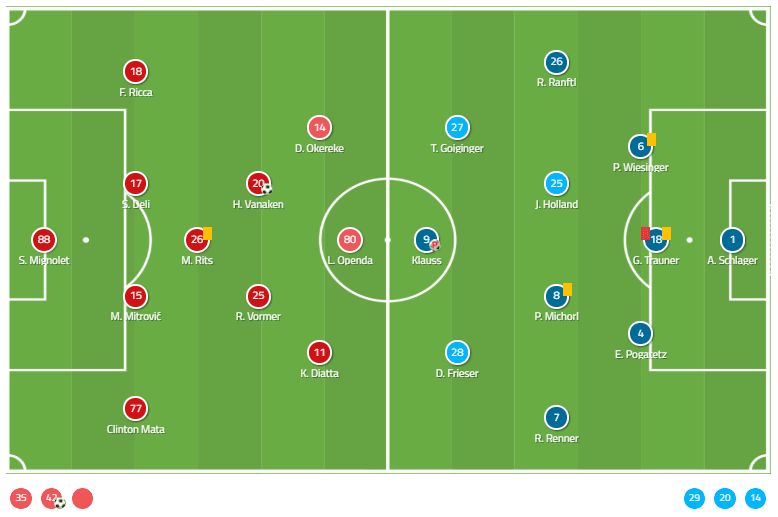
On the opposite side, Valérien Ismaël only made one change to the side that welcomed the Belgian side to their home ground. Dominik Frieser entered the starting lineup to occupy the left-winger spot for Salzburg loanee Samuel Tetteh. Completing the front line alongside him were João Klauss and Thomas Goiginger. At the back, veteran Emanuel Pogatetz paired up with captain Gernot Trauner and Philipp Wiesinger to screen in front of Alexander Schlager’s goal.
Club Brugge’s style of play
When Club Brugge were in possession, they tended to focus on building their attacks from the backline. Usually, centre-backs Matej Mitrović and Simon Deli stretched out wide and allowed defensive midfielder Mats Rits to split them and position himself centrally. Along with Mignolet, they created passing triangles inside their defensive third and focused on circulating the ball up the pitch.
Against LASK’s high pressure, this method prevented them from losing possession right inside their half. Furthermore, as the opposition usually pressed with three strikers up front, they would lose the numerical superiority and were forced to push another player up. It also meant that there were gaps being created at least inside the middle third for both Vanaken and Vormer to capitalise.
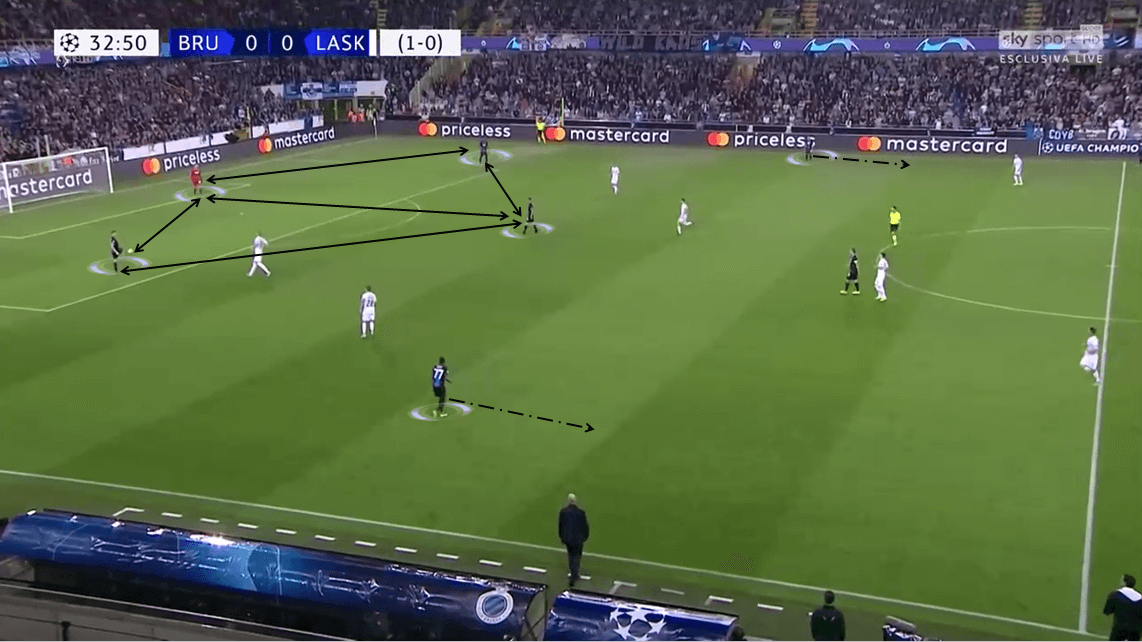
During the game, Rits’ role and positioning played a crucial part in the team’s transitioning process. He occupied the role of a half-back and anchored in the space between the defensive and the midfield lines. When they changed their status from defence to attack, he acted as a connection between the two centre-backs and the central midfielders up front. The Belgian midfielder also became a spare man in the passing block to help release the pressure that LASK put on them. This allowed both wing-backs, Clinton Mata and Ricca, to make progressive runs into the middle third ready for the attack.
In opposite situations, Rits dropped deep in between two centre-backs and created a back five. While the players up front started to put pressure on LASK’s build-up, the defensive line pushed higher up the pitch and located near the halfway line. It dragged along three attackers and prevented them from creating quick combinations inside their half.
They also adopted an offside trap which would catch them off in case they made runs into space behind their defensive line. Another responsibility of theirs was clearing long balls heading towards Klauss. Since the Hoffenheim loanee had the physicality to win the ball in the air, the defenders had to be on hand to clear it before he could even get to it.
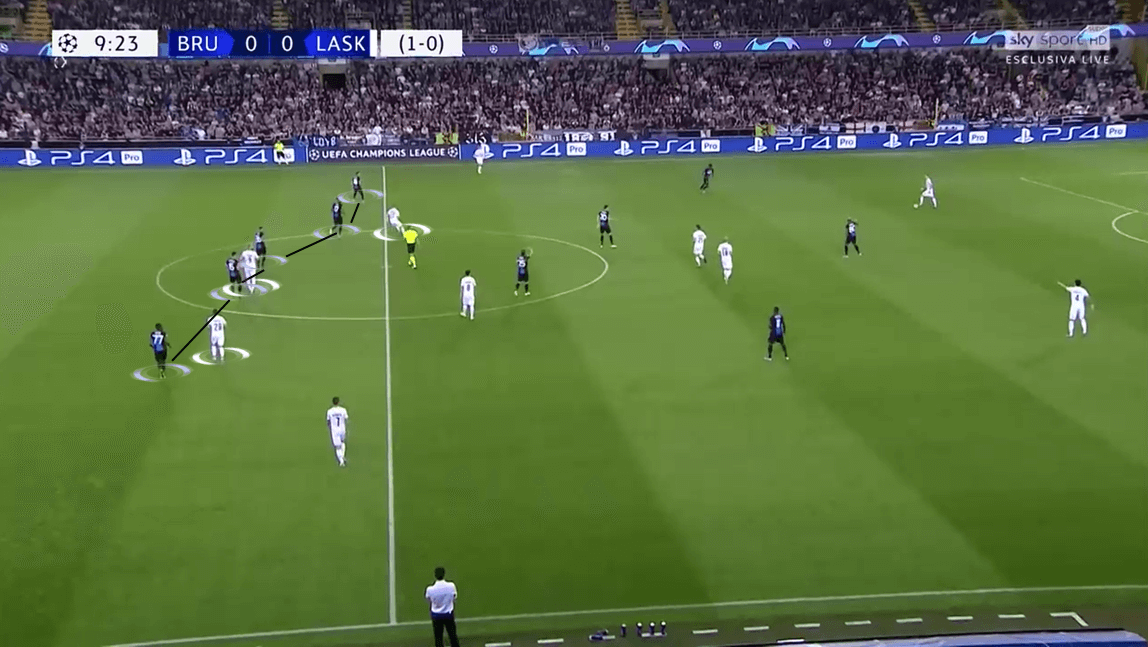
At times, their defensive line could even look like a 4-2-3-1. They defended compact and swarmed a certain area. Their aim was similar, prevent short and quick combinations between the line and eliminate passing options from the ball carrier.
But this left a problem on both flanks. As both wing-backs stayed close with the defensive line, they invited LASK’s wing-backs to overlap even higher. As this situation below shows us, Club Brugge’s defensive line stayed inside the central area. With technically no players around to mark them or at least track their runs, Reinhold Ranftl and Rene Renner could even run towards the box and pick up the long balls by ball carrier Peter Michorl.
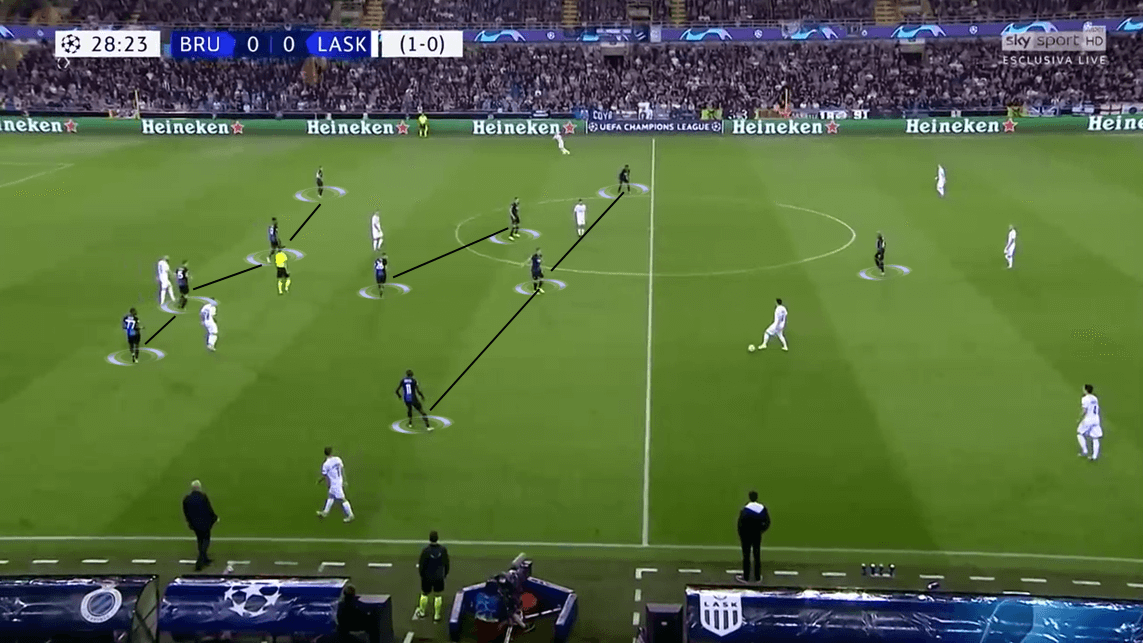
On the ball, they were extremely dangerous due to their quick combinations and pacey players. The likes of Mata (no, not that Mata you are thinking of), Diatta or Loïs Openda could capitalise the free space and sprint towards it. They would pick up the long pass or through ball to create a dangerous chance for Brugge.
In defence, LASK tended to overload the area in front of or surround the ball carrier. This required the whole defensive shape to shift across and swarmed that certain area. While this helped them in recovering possession as soon as possible, it also left a vulnerable threat for Schlager’s box.
If they weren’t able to win the ball back quickly, the ball carrier had the chance to change their attacking direction using a long pass. The destination of it would be the winger or wing-back on the opposite side. LASK’s players were forced to shift their structure across the pitch but when they were done with it, that player would have entered the box.
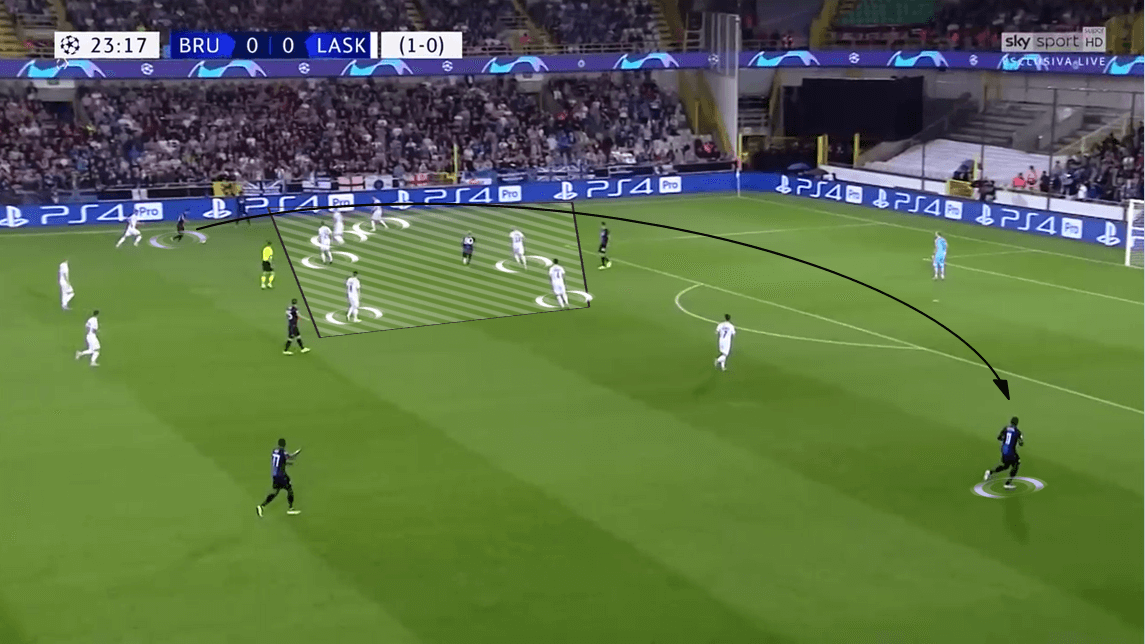
They had another method to beat the press which was creating passing triangles among the players. As a playmaker on the field, Vormer usually came close to help his teammates by offering to pick up the ball. He had the option of laying it to another player who was in an advanced position or dribbling on his own to continue the attack.
But in this case, he drifted into the half-space and linked up with the winger and the wing-back. Rather than having only two players to bypass the pressure and match with the opponent, Vormer became the intermediate to receive the ball and pass it to the other. Mata and Diatta usually benefitted from his style of play as they could link up with the rest and attack the wide area.
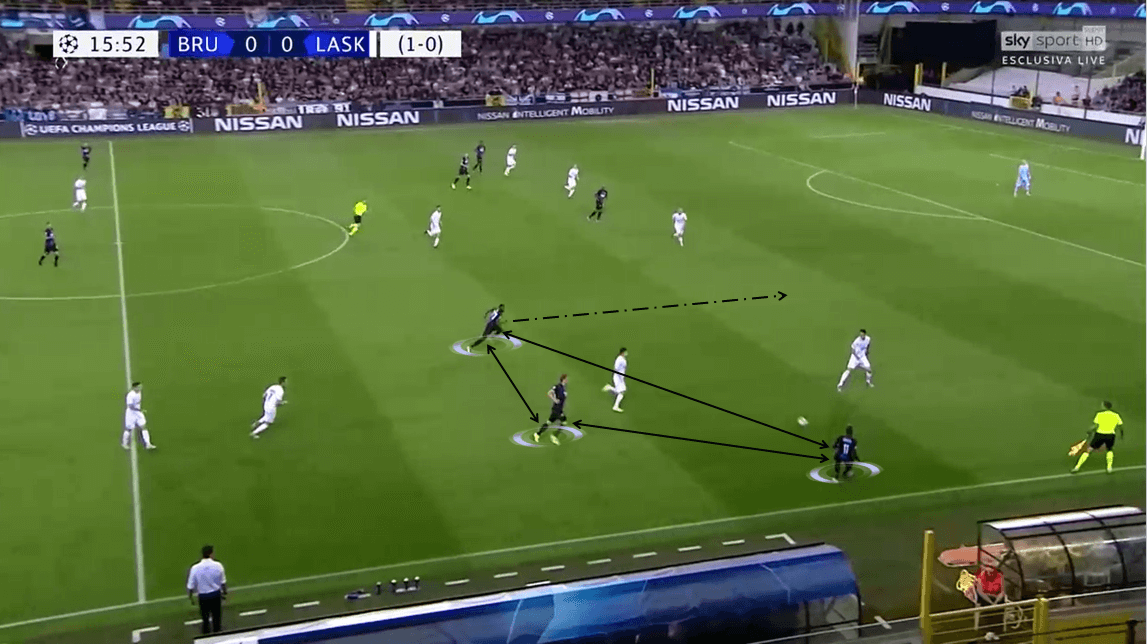
Besides assisting his teammates, Vormer’s positioning helped him to create chances for himself. While Brugge focused on attacking centrally, he was able to attack from deep and capitalise on the space created in between two centre-backs. His run broke that gap down as he entered the area behind LASK’s defensive line and was willing to receive a through ball.
In the shot below, the Belgian midfielder demonstrated exactly what is mentioned. He noticed that the space between Pogatetz and Renner was big enough for him to run in. Unfortunately, his run was a bit too early and he was caught in the offside trap when he received the ball.
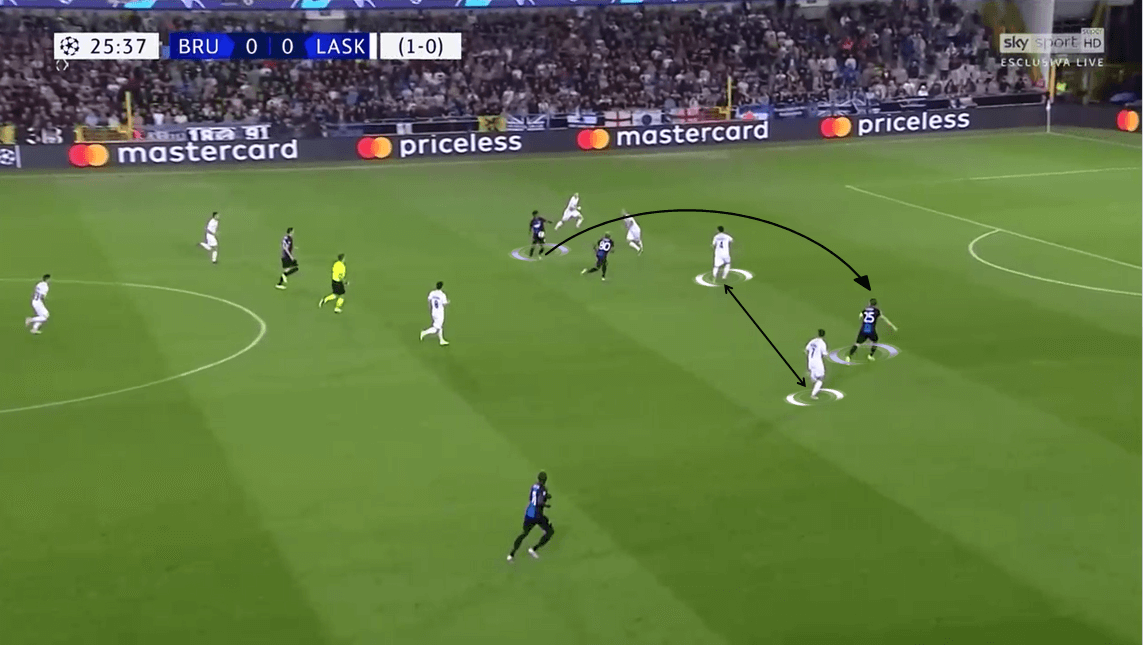
During the game, LASK left a lot of gaps inside their half when they defended. As their aim was to recover the ball, their centre-backs had the license to step out of the shape and get involved in duels. While they were able to put pressure on the ball carrier, it left the space behind their back vulnerable if his teammates weren’t able to cover it.
Using their positioning and pace, Brugge’s attackers could capitalise on this by making runs into that gap. After receiving the ball, they sprinted towards the goal and created a 1v1 situation with Schlager. In the shot below, substitute Percy Tau was put in a very active state after picking up the pass from David Okereke. He bypassed the pressure from Pogatetz and ended up facing Schlager. But in a very surprising turn, his shot deflected off the Austrian goalkeeper’s feet and somehow hit the post.
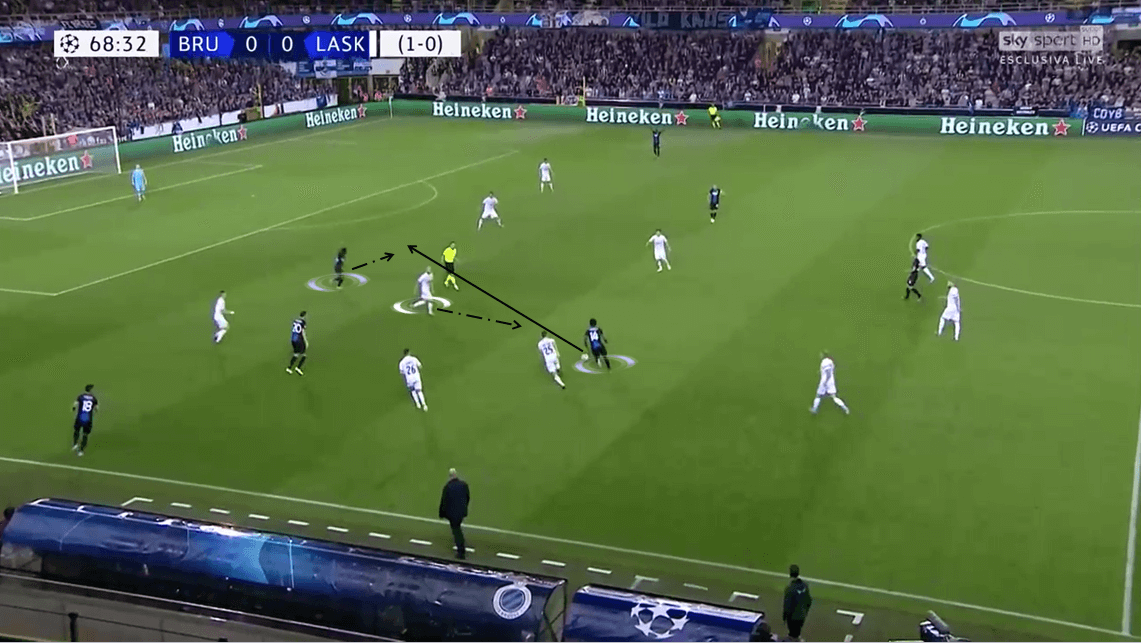
Luckily, just after that situation, Vanaken made up for Tau’s missed chance through a corner that the South African attackers won. Notice in the shot below how LASK’s players overloaded the 6-yard box but left three Brugge players free to continue their run into the area. Vormer’s corner fell right in front of Trauner and before the defender could do anything to clear it, Vanaken reached that spot to head it home.
Interestingly, LASK had seven players in the box and Tetteh marking the edge of the box compared to Brugge’s five. Not mentioning the two players positioned at the near post, Vanaken and Okereke were free enough to pick out space where they wanted to receive the ball. Renner and Wiesenger should have done better in marking them up as they were close to those two and were able to clear the ball out.
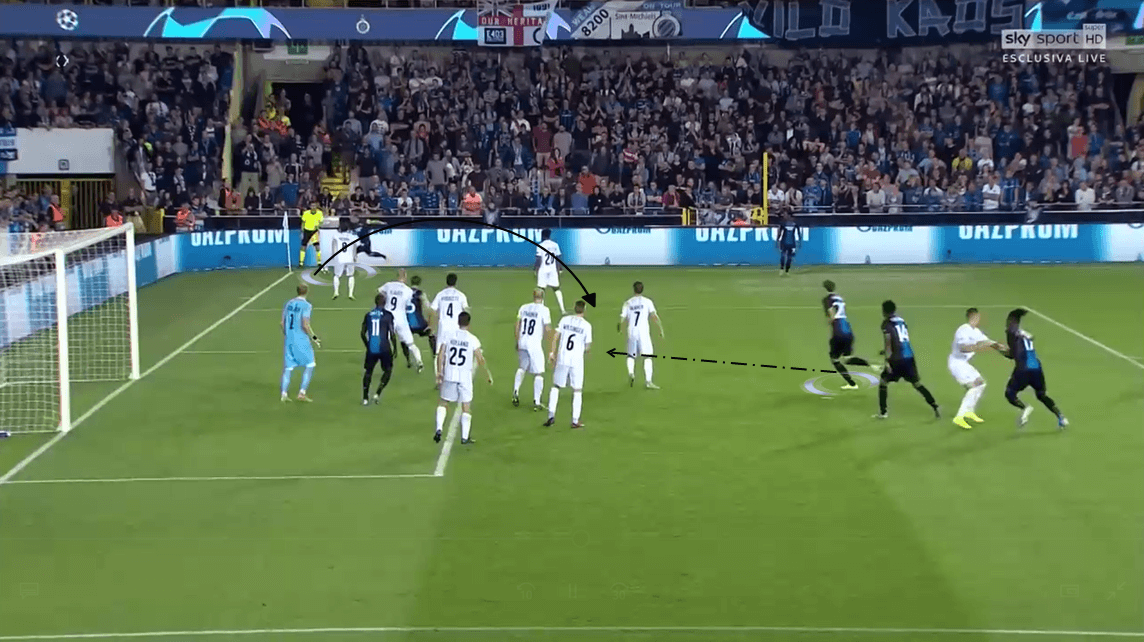
LASK’s style of play
As mentioned above, LASK had too many errors when they dealt with Brugge’s attacks. Firstly, they left gaps in between the defenders, allowing the opposition’s attackers to move in. This is vulnerable for the away side due to the fact that their players usually created quick combinations and relied on pace to beat the defensive line.
Secondly, they encountered troubles when marking the opposition. Although this wasn’t shown occasionally during the match, Vanaken capitalised this to score the opening goal of the game.
Thirdly, their players weren’t able to recover from their positions during a few of their pressing situations. When they pressed the opposition’s build-up, they adopted a man-oriented marking strategy which required each player to follow one of Club Brugge’s players.
While this helped them in disrupting the ball circulation, it also left the defensive line vulnerable. During the press, both wing-backs were also responsible for two wingers and if they moved back into their half, they had to follow them. This forced the centre-backs to stretch out and occupy the wide-area, allowing the striker to move flexibly among them.
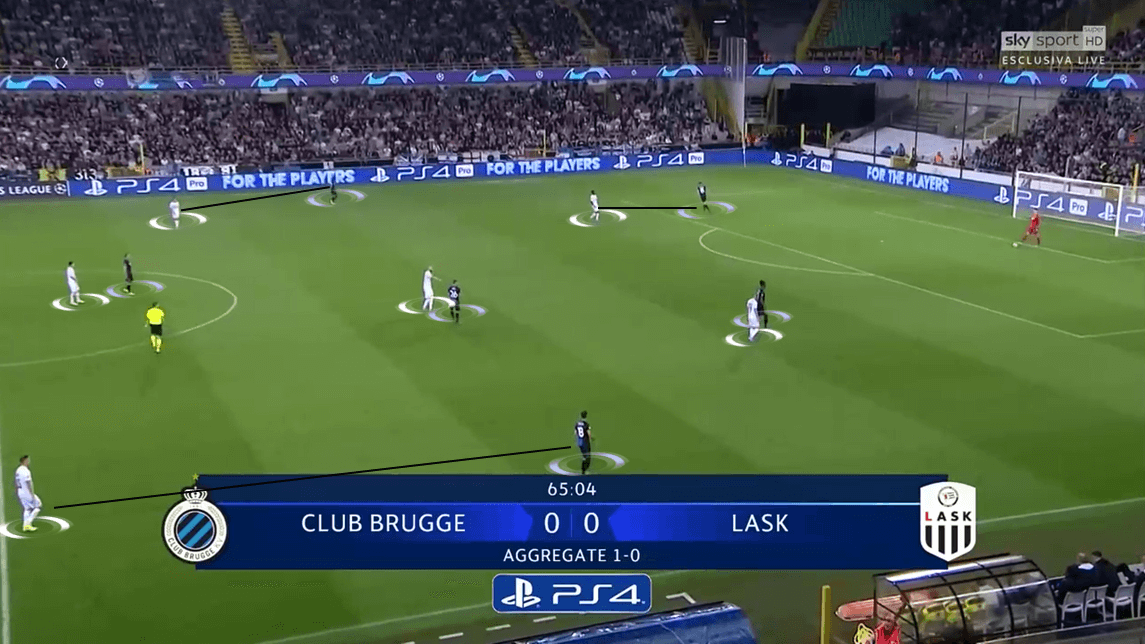
When the ball entered their half, they would form a 5-2-3 defensive structure and kept the pressing principles. The defensive line stretched wide and attempted to fill in both the central area and the half-spaces. It created the flexibility when they shifted the shape laterally to create overloads on both wings.
Meanwhile, three strikers paired up with two of the central midfielders and created a cage surrounding the ball carrier. They adopted an aggressive attitude when they tackled the ball away from the opposition which led to unnecessary fouls around the box. As a player tried to close the ball carrier down, the other would search for potential receivers around him and marked them up.
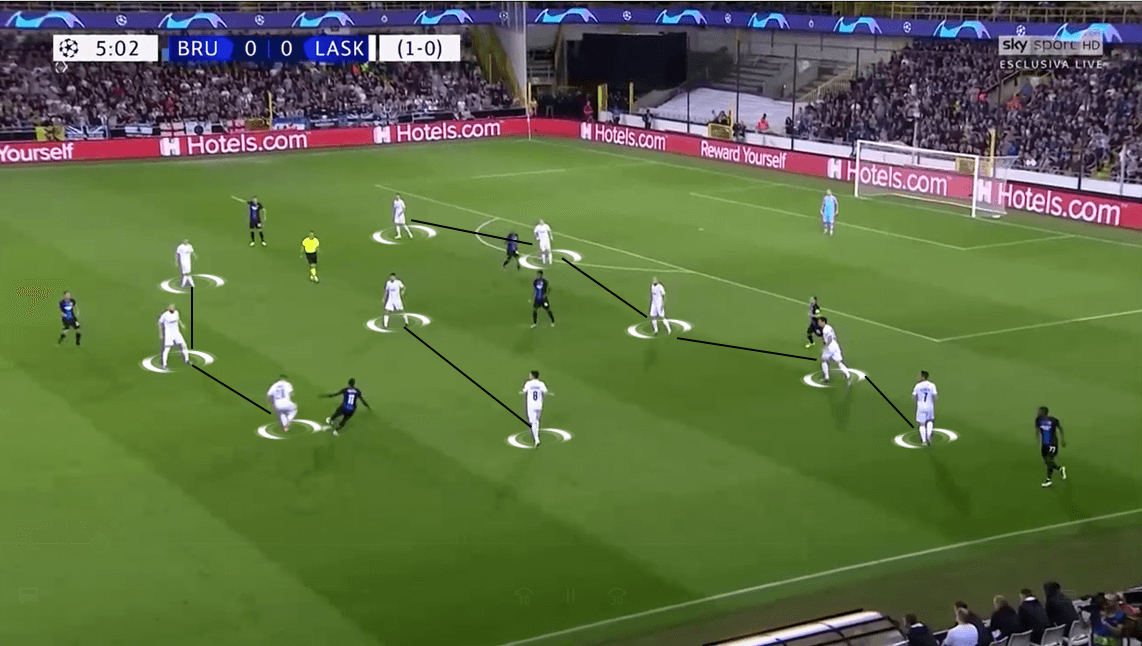
In attacks, they were a wing-oriented team and created most of their chances on both wings. This also required the understanding between the wingers and the wing-backs to open up spaces for either to move in. As the wingers, Goiginger and Frieser, tended to cut inside and sat on the shoulders of defenders, it allowed both wing-backs to overlap into the opposition’s half.
With three players positioned centrally, this pinned down Brugge’s defensive line as they had to close them down. Although one could have stepped out of the line and marked the wing-back, three 3v3 situations occurring inside the box weren’t what the home side aimed for. In that case, either Renner or Ranftl would lay the ball back to Michorl and a pass would be followed up, heading towards the strikers for a dangerous chance.
Still, they didn’t have many chances to execute what they had planned. Due to the fact that LASK weren’t holding much of the ball possession during some periods of the game (their total ball possession percentage was 43%), it created a tough situation where they had to defend and recover the ball.
Furthermore, in their total of eleven chances in this game, six of them were blocked, that’s more than half of it. They still managed to get four on target but none of them were enough to force Mignolet to show his full ability. Klauss’ penalty at the 74th minute showed a glimpse of hope that they could cause an upset but after that, the home side started to push their tempo up again and threaten Schlager’s goal on several occasions. Trauner’s red-card just seven minutes later even made things harder for LASK and eventually they bowed out of the Champions League when Bonaventure scored the winning goal.
Conclusion
From a tactical perspective, this was a fascinating match to watch as both teams showed what they are capable of. For Club Brugge, their style of play which relied on combinations and the players’ pace caused many troubles for LASK’s defenders. Two goals from Vanaken and Bonaventure were the perfect reward for the efforts that they put into this match.
LASK’s Champions League journey has officially ended but they have left their mark in every match that they have played. Still, their European journey hasn’t ended yet as they will enter the Europa League group stage along with Wolfsberger. At the time of writing, LASK’s opponents have been confirmed as Sporting Lisbon, PSV Eindhoven and Rosenborg. Valérien Ismaël and his side will head towards the group stage with high confidence but they also need to fix the problems that were shown in this match.

If you love tactical analysis, then you’ll love the digital magazines from totalfootballanalysis.com – a guaranteed 100+ pages of pure tactical analysis covering topics from the Premier League, Serie A, La Liga, Bundesliga and many, many more. Buy your copy of the August issue for just ₤4.99 here.

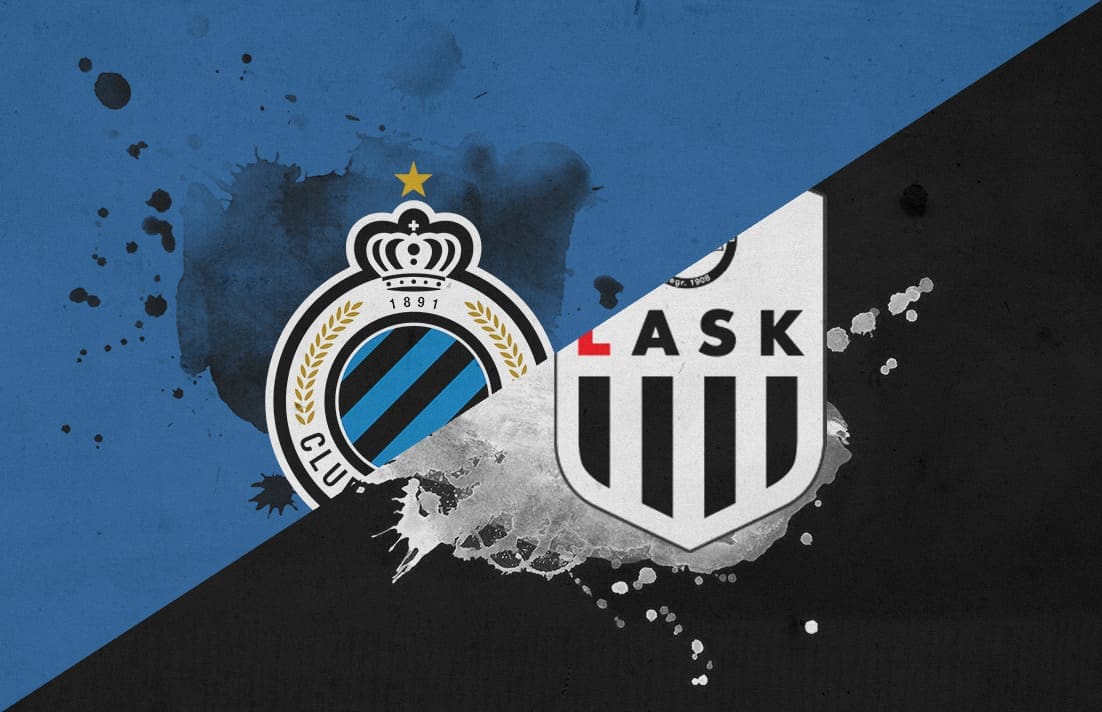


Comments